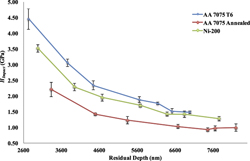Article contents
Characterization and investigation of size effect in nano-impact indentations performed using cube-corner indenter tip
Published online by Cambridge University Press: 22 May 2017
Abstract

The traditional macro-scale form of dynamic indentation measures the dynamic deformation behavior of a material by simulating impact conditions. Similarly, the nano-impact indentation technique, with small-scale contacts and high spatial resolutions, is a novel technique for obtaining mechanical properties of materials at dynamic strain rates (>102 s−1). Nano-impact hardness values display a decreasing trend or size effect that continues for several micrometers of indentation depth, compared to the primarily sub micrometer depth range of size effect in quasi-static nanoindentations. For the first time, the factors behind the enhanced size effects for dynamic micro-scale indentations have been investigated by the current work: non-uniform loading and resulting instability using strain rate profiles, plastic wave behavior during loading using resistance force versus indentation depth profiles, quantification of energy of the dynamic plastic wave, and localization of impact strain using electron backscattered diffraction (EBSD) mapping of the strain affected vicinity of indentation imprints.
Keywords
- Type
- Articles
- Information
- Copyright
- Copyright © Materials Research Society 2017
Footnotes
Contributing Editor: Jürgen Eckert
References
REFERENCES
- 10
- Cited by





